Exploring Market Structures and Business Strategies
VerifiedAdded on 2020/04/15
|17
|3511
|53
AI Summary
The assignment provides a comprehensive analysis of different market structures—monopoly, duopoly, oligopoly, and monopolistic competition—and their implications for business strategies. In monopolies, a single firm dominates the market with significant control over prices due to high entry barriers and lack of substitutes. Duopolies feature two main competitors whose strategic decisions directly affect each other’s outcomes, often leading to competitive or cooperative behaviors based on game theory principles. Oligopolies consist of a few dominant firms that can collude to set prices or outputs but may also engage in intense competition. Monopolistic competition involves many firms offering differentiated products with some degree of market power due to brand loyalty and product variation. The assignment evaluates how these structures impact pricing strategies, consumer choices, and overall economic efficiency, using theoretical frameworks and real-world examples to illustrate key points.
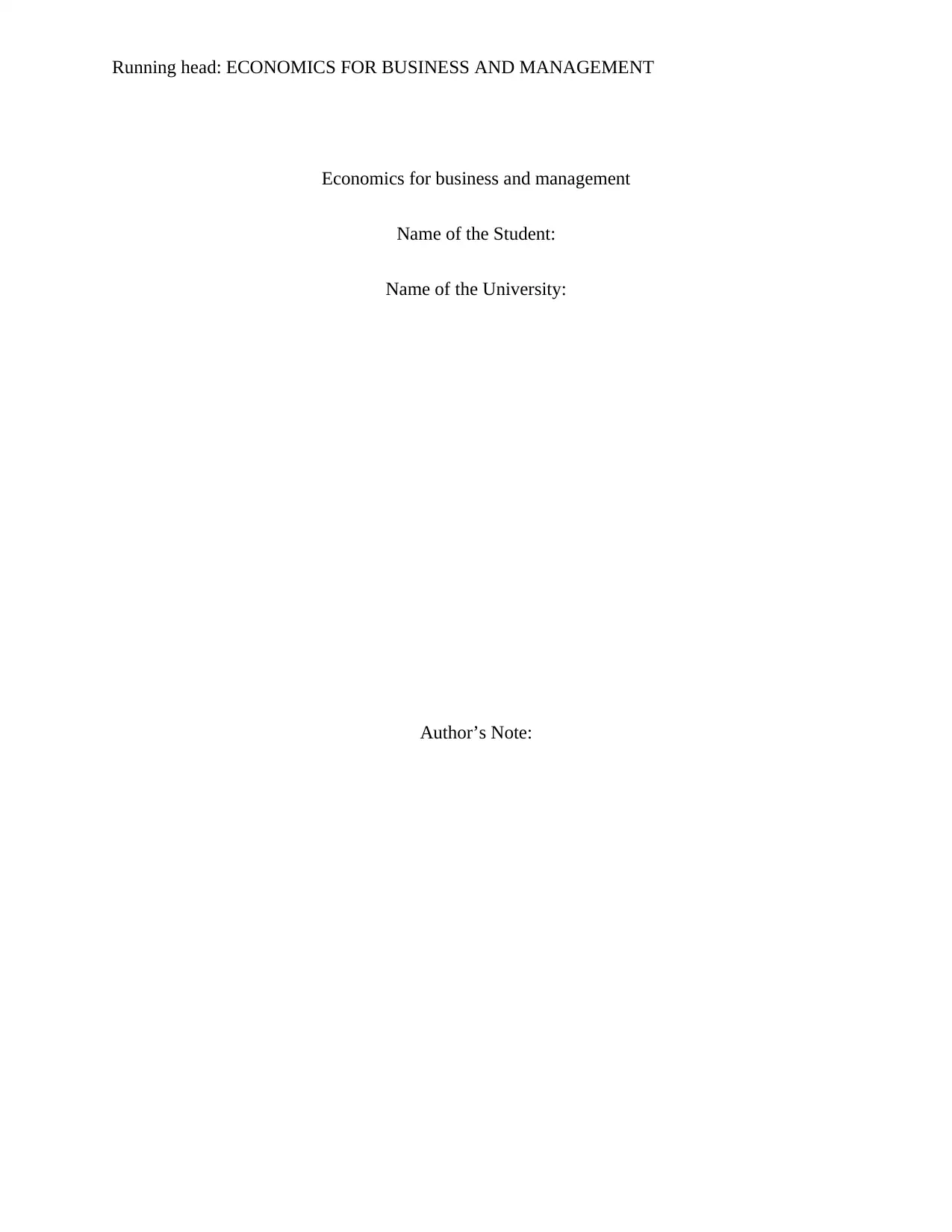
Running head: ECONOMICS FOR BUSINESS AND MANAGEMENT
Economics for business and management
Name of the Student:
Name of the University:
Author’s Note:
Economics for business and management
Name of the Student:
Name of the University:
Author’s Note:
Paraphrase This Document
Need a fresh take? Get an instant paraphrase of this document with our AI Paraphraser

1
ECONOMICS FOR BUSINESS AND MANAGEMENT
Table of Contents
Answer to question 1:......................................................................................................................2
Answer to question 2:......................................................................................................................4
Key differences between different types of market structures:.......................................................4
Theoretical construct market and market structures and market that exist in practice:...................9
Market structure of rail industry in Britain:...................................................................................11
References list:...............................................................................................................................14
ECONOMICS FOR BUSINESS AND MANAGEMENT
Table of Contents
Answer to question 1:......................................................................................................................2
Answer to question 2:......................................................................................................................4
Key differences between different types of market structures:.......................................................4
Theoretical construct market and market structures and market that exist in practice:...................9
Market structure of rail industry in Britain:...................................................................................11
References list:...............................................................................................................................14
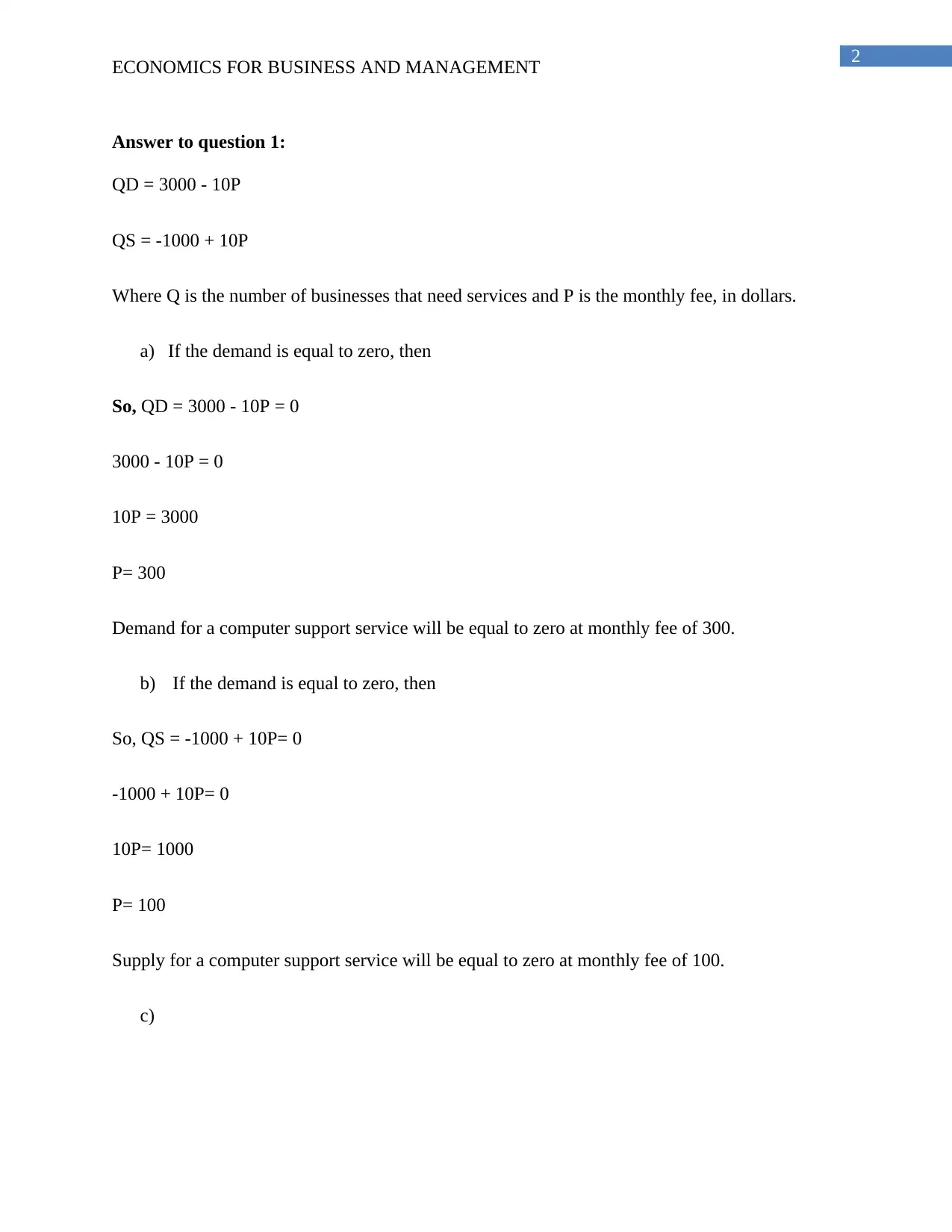
2
ECONOMICS FOR BUSINESS AND MANAGEMENT
Answer to question 1:
QD = 3000 - 10P
QS = -1000 + 10P
Where Q is the number of businesses that need services and P is the monthly fee, in dollars.
a) If the demand is equal to zero, then
So, QD = 3000 - 10P = 0
3000 - 10P = 0
10P = 3000
P= 300
Demand for a computer support service will be equal to zero at monthly fee of 300.
b) If the demand is equal to zero, then
So, QS = -1000 + 10P= 0
-1000 + 10P= 0
10P= 1000
P= 100
Supply for a computer support service will be equal to zero at monthly fee of 100.
c)
ECONOMICS FOR BUSINESS AND MANAGEMENT
Answer to question 1:
QD = 3000 - 10P
QS = -1000 + 10P
Where Q is the number of businesses that need services and P is the monthly fee, in dollars.
a) If the demand is equal to zero, then
So, QD = 3000 - 10P = 0
3000 - 10P = 0
10P = 3000
P= 300
Demand for a computer support service will be equal to zero at monthly fee of 300.
b) If the demand is equal to zero, then
So, QS = -1000 + 10P= 0
-1000 + 10P= 0
10P= 1000
P= 100
Supply for a computer support service will be equal to zero at monthly fee of 100.
c)
⊘ This is a preview!⊘
Do you want full access?
Subscribe today to unlock all pages.

Trusted by 1+ million students worldwide
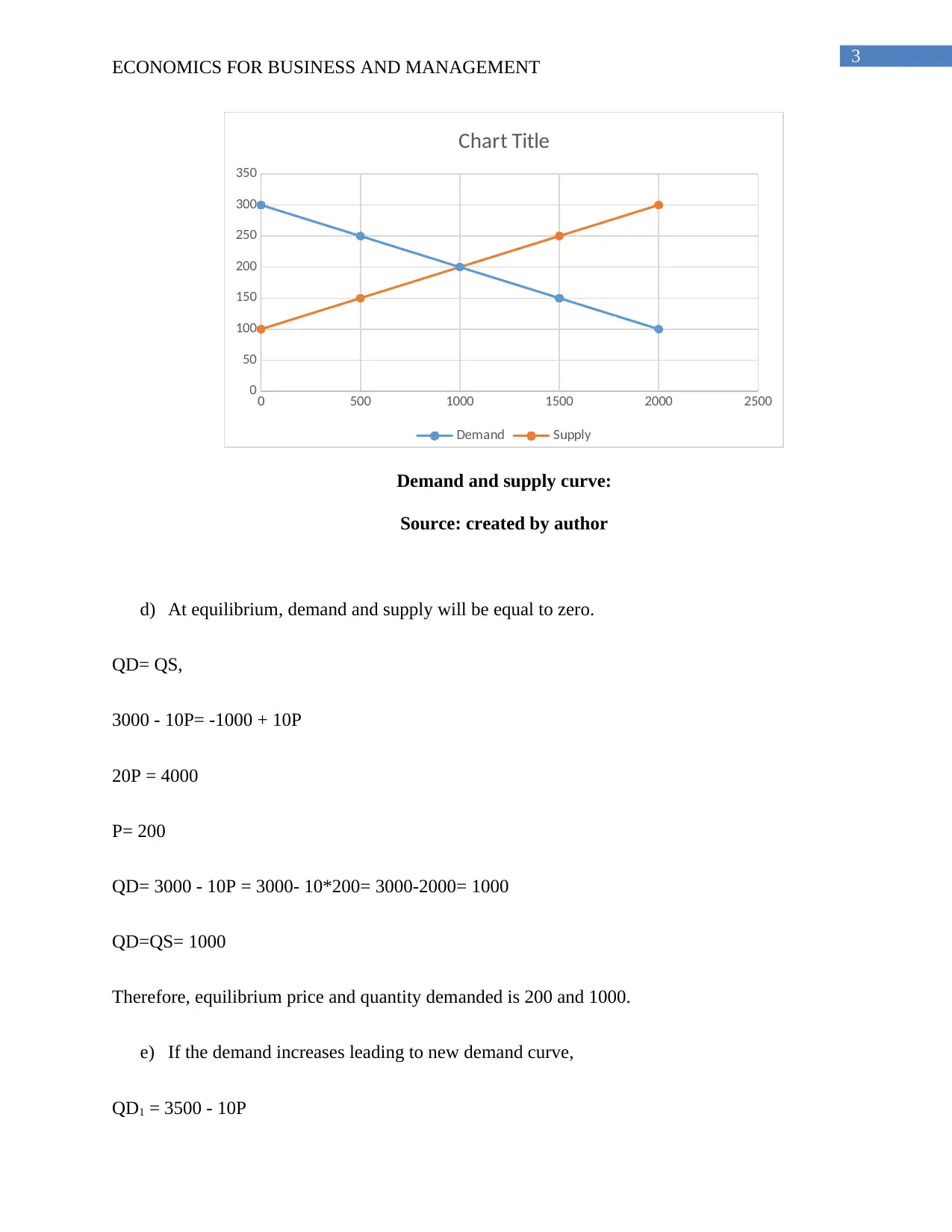
3
ECONOMICS FOR BUSINESS AND MANAGEMENT
0 500 1000 1500 2000 2500
0
50
100
150
200
250
300
350
Chart Title
Demand Supply
Demand and supply curve:
Source: created by author
d) At equilibrium, demand and supply will be equal to zero.
QD= QS,
3000 - 10P= -1000 + 10P
20P = 4000
P= 200
QD= 3000 - 10P = 3000- 10*200= 3000-2000= 1000
QD=QS= 1000
Therefore, equilibrium price and quantity demanded is 200 and 1000.
e) If the demand increases leading to new demand curve,
QD1 = 3500 - 10P
ECONOMICS FOR BUSINESS AND MANAGEMENT
0 500 1000 1500 2000 2500
0
50
100
150
200
250
300
350
Chart Title
Demand Supply
Demand and supply curve:
Source: created by author
d) At equilibrium, demand and supply will be equal to zero.
QD= QS,
3000 - 10P= -1000 + 10P
20P = 4000
P= 200
QD= 3000 - 10P = 3000- 10*200= 3000-2000= 1000
QD=QS= 1000
Therefore, equilibrium price and quantity demanded is 200 and 1000.
e) If the demand increases leading to new demand curve,
QD1 = 3500 - 10P
Paraphrase This Document
Need a fresh take? Get an instant paraphrase of this document with our AI Paraphraser
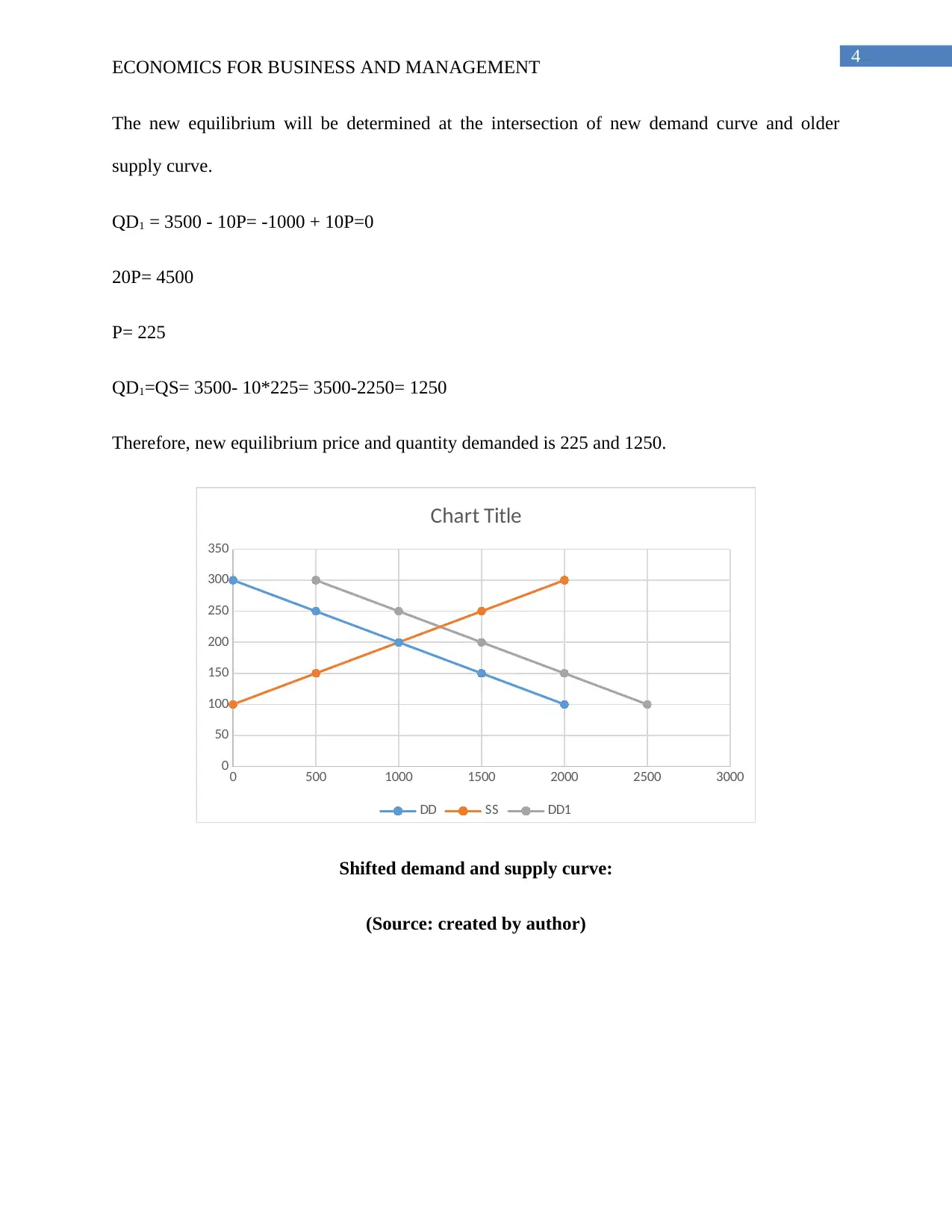
4
ECONOMICS FOR BUSINESS AND MANAGEMENT
The new equilibrium will be determined at the intersection of new demand curve and older
supply curve.
QD1 = 3500 - 10P= -1000 + 10P=0
20P= 4500
P= 225
QD1=QS= 3500- 10*225= 3500-2250= 1250
Therefore, new equilibrium price and quantity demanded is 225 and 1250.
0 500 1000 1500 2000 2500 3000
0
50
100
150
200
250
300
350
Chart Title
DD SS DD1
Shifted demand and supply curve:
(Source: created by author)
ECONOMICS FOR BUSINESS AND MANAGEMENT
The new equilibrium will be determined at the intersection of new demand curve and older
supply curve.
QD1 = 3500 - 10P= -1000 + 10P=0
20P= 4500
P= 225
QD1=QS= 3500- 10*225= 3500-2250= 1250
Therefore, new equilibrium price and quantity demanded is 225 and 1250.
0 500 1000 1500 2000 2500 3000
0
50
100
150
200
250
300
350
Chart Title
DD SS DD1
Shifted demand and supply curve:
(Source: created by author)

5
ECONOMICS FOR BUSINESS AND MANAGEMENT
Answer to question 2:
Key differences between different types of market structures:
Perfect competition- Perfect competition is a market structure where a large number of
sellers as well as buyers exist and the behaviour and action of each of the individual does not
have any impact on market quantity and price. The fact that not even a single firm is able to
influence market price depicts that socially optimum output level of output. This particular
market structure is based on the assumptions that there is a free entry and exit of firms, there
does not exist any preferences of customers and homogenous or identical goods are sold by all
firms. Theoretically, it the market structure that produces socially optimum level of output
(Anderson et al. 2014). However, it is quite difficult to find this type of market in reality.
Perfectly competitive market is a price taker sine they don’t have any control over the
price of products. The demand and supply conditions of the market determines equilibrium price
and quantity that cannot be influenced by any single firm operating in market. Existing firms in
the market are exposed to competition from new firms entering into market that makes it
possible for firm to influence market price. Therefore, the firms is required to adjust to market
price or it should take the market price. Since, there is no control over price of firms, the thing
that is controlled by firms are quantity of output. Output is produced in such a way that their
profit are maximized (Tedlow 2014).
The demand curve faced by perfectly competitive firm is horizontal and price and
marginal revenue of products is equal. Average revenue of products sold is also equal to price of
product because firms influence to alter price and thereby quantity sold is negligible. Hence,
ECONOMICS FOR BUSINESS AND MANAGEMENT
Answer to question 2:
Key differences between different types of market structures:
Perfect competition- Perfect competition is a market structure where a large number of
sellers as well as buyers exist and the behaviour and action of each of the individual does not
have any impact on market quantity and price. The fact that not even a single firm is able to
influence market price depicts that socially optimum output level of output. This particular
market structure is based on the assumptions that there is a free entry and exit of firms, there
does not exist any preferences of customers and homogenous or identical goods are sold by all
firms. Theoretically, it the market structure that produces socially optimum level of output
(Anderson et al. 2014). However, it is quite difficult to find this type of market in reality.
Perfectly competitive market is a price taker sine they don’t have any control over the
price of products. The demand and supply conditions of the market determines equilibrium price
and quantity that cannot be influenced by any single firm operating in market. Existing firms in
the market are exposed to competition from new firms entering into market that makes it
possible for firm to influence market price. Therefore, the firms is required to adjust to market
price or it should take the market price. Since, there is no control over price of firms, the thing
that is controlled by firms are quantity of output. Output is produced in such a way that their
profit are maximized (Tedlow 2014).
The demand curve faced by perfectly competitive firm is horizontal and price and
marginal revenue of products is equal. Average revenue of products sold is also equal to price of
product because firms influence to alter price and thereby quantity sold is negligible. Hence,
⊘ This is a preview!⊘
Do you want full access?
Subscribe today to unlock all pages.

Trusted by 1+ million students worldwide
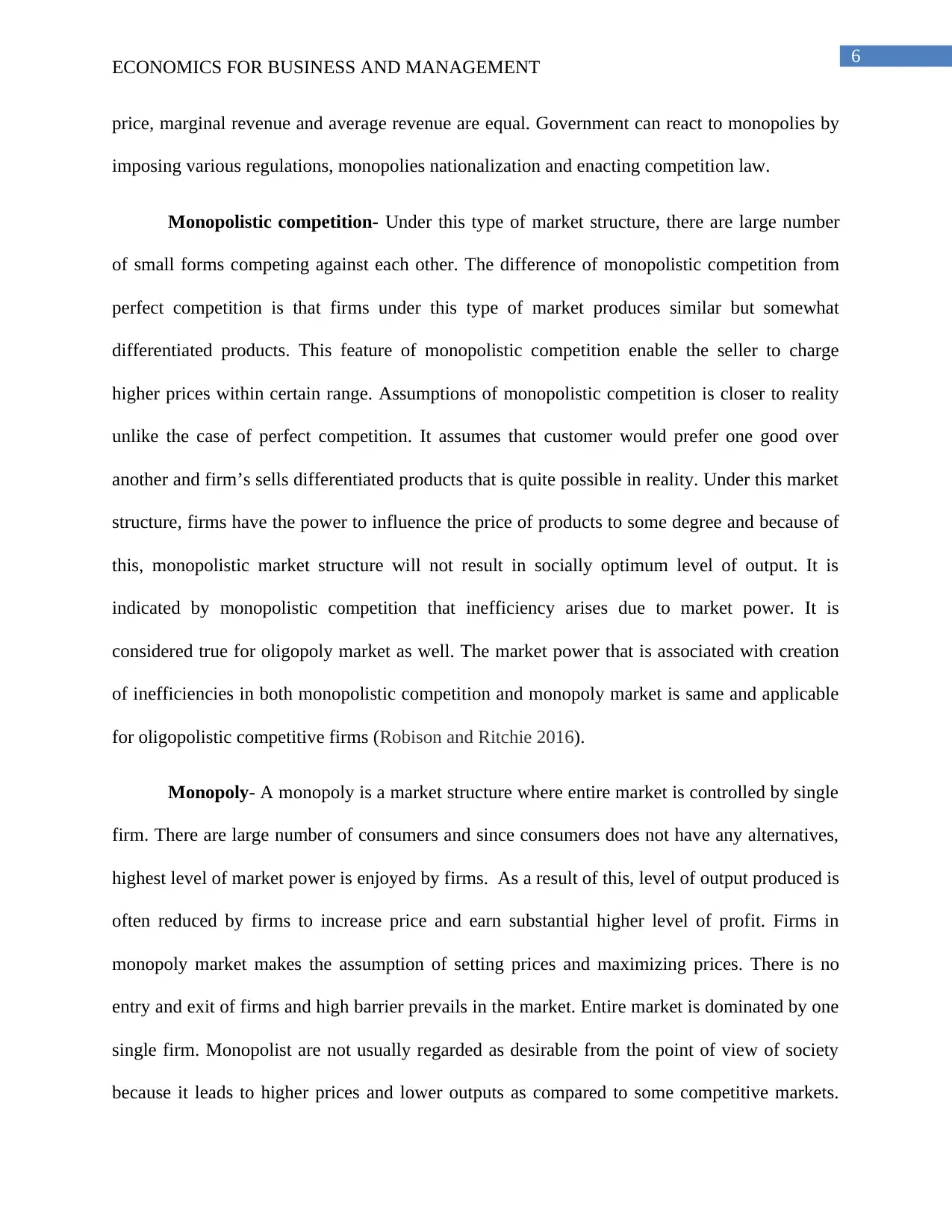
6
ECONOMICS FOR BUSINESS AND MANAGEMENT
price, marginal revenue and average revenue are equal. Government can react to monopolies by
imposing various regulations, monopolies nationalization and enacting competition law.
Monopolistic competition- Under this type of market structure, there are large number
of small forms competing against each other. The difference of monopolistic competition from
perfect competition is that firms under this type of market produces similar but somewhat
differentiated products. This feature of monopolistic competition enable the seller to charge
higher prices within certain range. Assumptions of monopolistic competition is closer to reality
unlike the case of perfect competition. It assumes that customer would prefer one good over
another and firm’s sells differentiated products that is quite possible in reality. Under this market
structure, firms have the power to influence the price of products to some degree and because of
this, monopolistic market structure will not result in socially optimum level of output. It is
indicated by monopolistic competition that inefficiency arises due to market power. It is
considered true for oligopoly market as well. The market power that is associated with creation
of inefficiencies in both monopolistic competition and monopoly market is same and applicable
for oligopolistic competitive firms (Robison and Ritchie 2016).
Monopoly- A monopoly is a market structure where entire market is controlled by single
firm. There are large number of consumers and since consumers does not have any alternatives,
highest level of market power is enjoyed by firms. As a result of this, level of output produced is
often reduced by firms to increase price and earn substantial higher level of profit. Firms in
monopoly market makes the assumption of setting prices and maximizing prices. There is no
entry and exit of firms and high barrier prevails in the market. Entire market is dominated by one
single firm. Monopolist are not usually regarded as desirable from the point of view of society
because it leads to higher prices and lower outputs as compared to some competitive markets.
ECONOMICS FOR BUSINESS AND MANAGEMENT
price, marginal revenue and average revenue are equal. Government can react to monopolies by
imposing various regulations, monopolies nationalization and enacting competition law.
Monopolistic competition- Under this type of market structure, there are large number
of small forms competing against each other. The difference of monopolistic competition from
perfect competition is that firms under this type of market produces similar but somewhat
differentiated products. This feature of monopolistic competition enable the seller to charge
higher prices within certain range. Assumptions of monopolistic competition is closer to reality
unlike the case of perfect competition. It assumes that customer would prefer one good over
another and firm’s sells differentiated products that is quite possible in reality. Under this market
structure, firms have the power to influence the price of products to some degree and because of
this, monopolistic market structure will not result in socially optimum level of output. It is
indicated by monopolistic competition that inefficiency arises due to market power. It is
considered true for oligopoly market as well. The market power that is associated with creation
of inefficiencies in both monopolistic competition and monopoly market is same and applicable
for oligopolistic competitive firms (Robison and Ritchie 2016).
Monopoly- A monopoly is a market structure where entire market is controlled by single
firm. There are large number of consumers and since consumers does not have any alternatives,
highest level of market power is enjoyed by firms. As a result of this, level of output produced is
often reduced by firms to increase price and earn substantial higher level of profit. Firms in
monopoly market makes the assumption of setting prices and maximizing prices. There is no
entry and exit of firms and high barrier prevails in the market. Entire market is dominated by one
single firm. Monopolist are not usually regarded as desirable from the point of view of society
because it leads to higher prices and lower outputs as compared to some competitive markets.
Paraphrase This Document
Need a fresh take? Get an instant paraphrase of this document with our AI Paraphraser
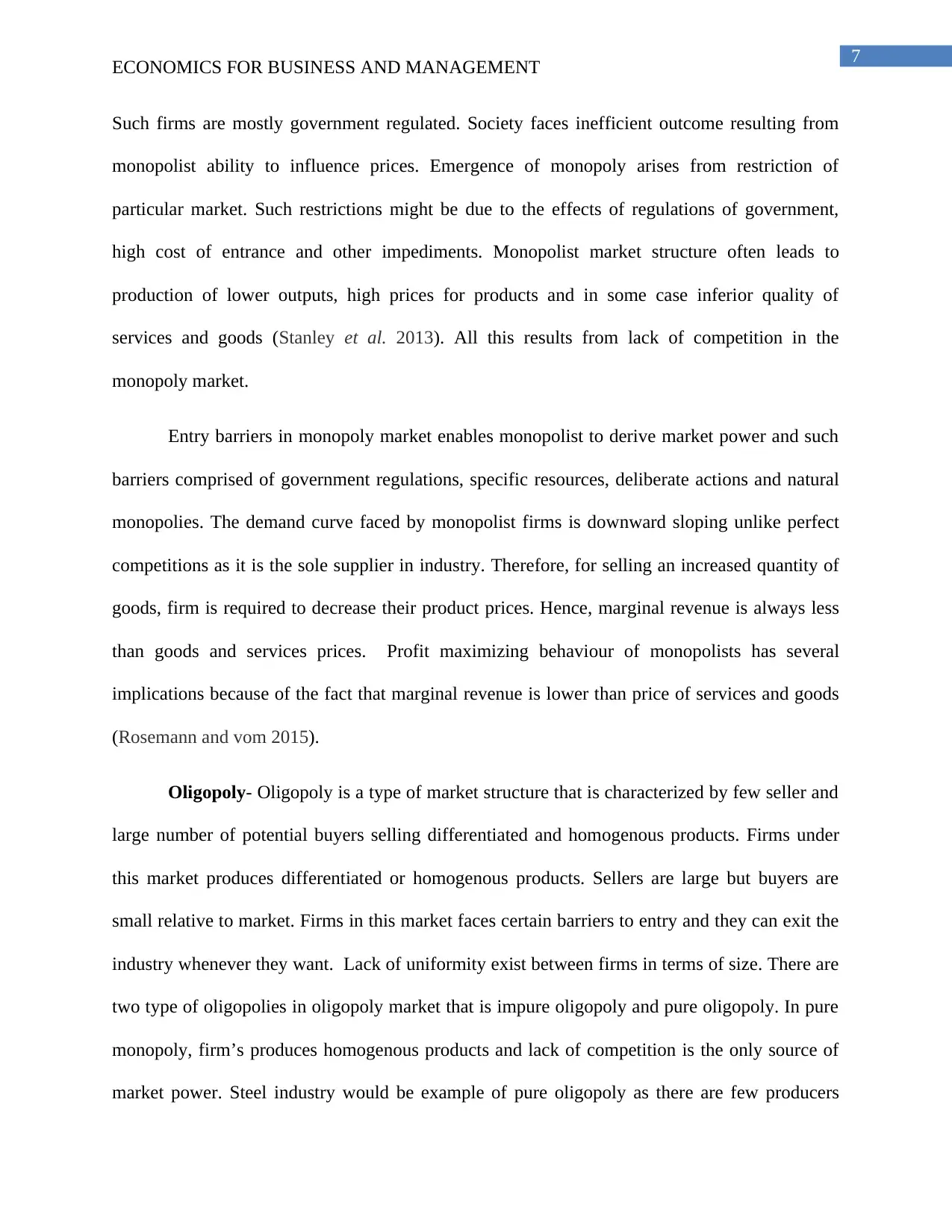
7
ECONOMICS FOR BUSINESS AND MANAGEMENT
Such firms are mostly government regulated. Society faces inefficient outcome resulting from
monopolist ability to influence prices. Emergence of monopoly arises from restriction of
particular market. Such restrictions might be due to the effects of regulations of government,
high cost of entrance and other impediments. Monopolist market structure often leads to
production of lower outputs, high prices for products and in some case inferior quality of
services and goods (Stanley et al. 2013). All this results from lack of competition in the
monopoly market.
Entry barriers in monopoly market enables monopolist to derive market power and such
barriers comprised of government regulations, specific resources, deliberate actions and natural
monopolies. The demand curve faced by monopolist firms is downward sloping unlike perfect
competitions as it is the sole supplier in industry. Therefore, for selling an increased quantity of
goods, firm is required to decrease their product prices. Hence, marginal revenue is always less
than goods and services prices. Profit maximizing behaviour of monopolists has several
implications because of the fact that marginal revenue is lower than price of services and goods
(Rosemann and vom 2015).
Oligopoly- Oligopoly is a type of market structure that is characterized by few seller and
large number of potential buyers selling differentiated and homogenous products. Firms under
this market produces differentiated or homogenous products. Sellers are large but buyers are
small relative to market. Firms in this market faces certain barriers to entry and they can exit the
industry whenever they want. Lack of uniformity exist between firms in terms of size. There are
two type of oligopolies in oligopoly market that is impure oligopoly and pure oligopoly. In pure
monopoly, firm’s produces homogenous products and lack of competition is the only source of
market power. Steel industry would be example of pure oligopoly as there are few producers
ECONOMICS FOR BUSINESS AND MANAGEMENT
Such firms are mostly government regulated. Society faces inefficient outcome resulting from
monopolist ability to influence prices. Emergence of monopoly arises from restriction of
particular market. Such restrictions might be due to the effects of regulations of government,
high cost of entrance and other impediments. Monopolist market structure often leads to
production of lower outputs, high prices for products and in some case inferior quality of
services and goods (Stanley et al. 2013). All this results from lack of competition in the
monopoly market.
Entry barriers in monopoly market enables monopolist to derive market power and such
barriers comprised of government regulations, specific resources, deliberate actions and natural
monopolies. The demand curve faced by monopolist firms is downward sloping unlike perfect
competitions as it is the sole supplier in industry. Therefore, for selling an increased quantity of
goods, firm is required to decrease their product prices. Hence, marginal revenue is always less
than goods and services prices. Profit maximizing behaviour of monopolists has several
implications because of the fact that marginal revenue is lower than price of services and goods
(Rosemann and vom 2015).
Oligopoly- Oligopoly is a type of market structure that is characterized by few seller and
large number of potential buyers selling differentiated and homogenous products. Firms under
this market produces differentiated or homogenous products. Sellers are large but buyers are
small relative to market. Firms in this market faces certain barriers to entry and they can exit the
industry whenever they want. Lack of uniformity exist between firms in terms of size. There are
two type of oligopolies in oligopoly market that is impure oligopoly and pure oligopoly. In pure
monopoly, firm’s produces homogenous products and lack of competition is the only source of
market power. Steel industry would be example of pure oligopoly as there are few producers
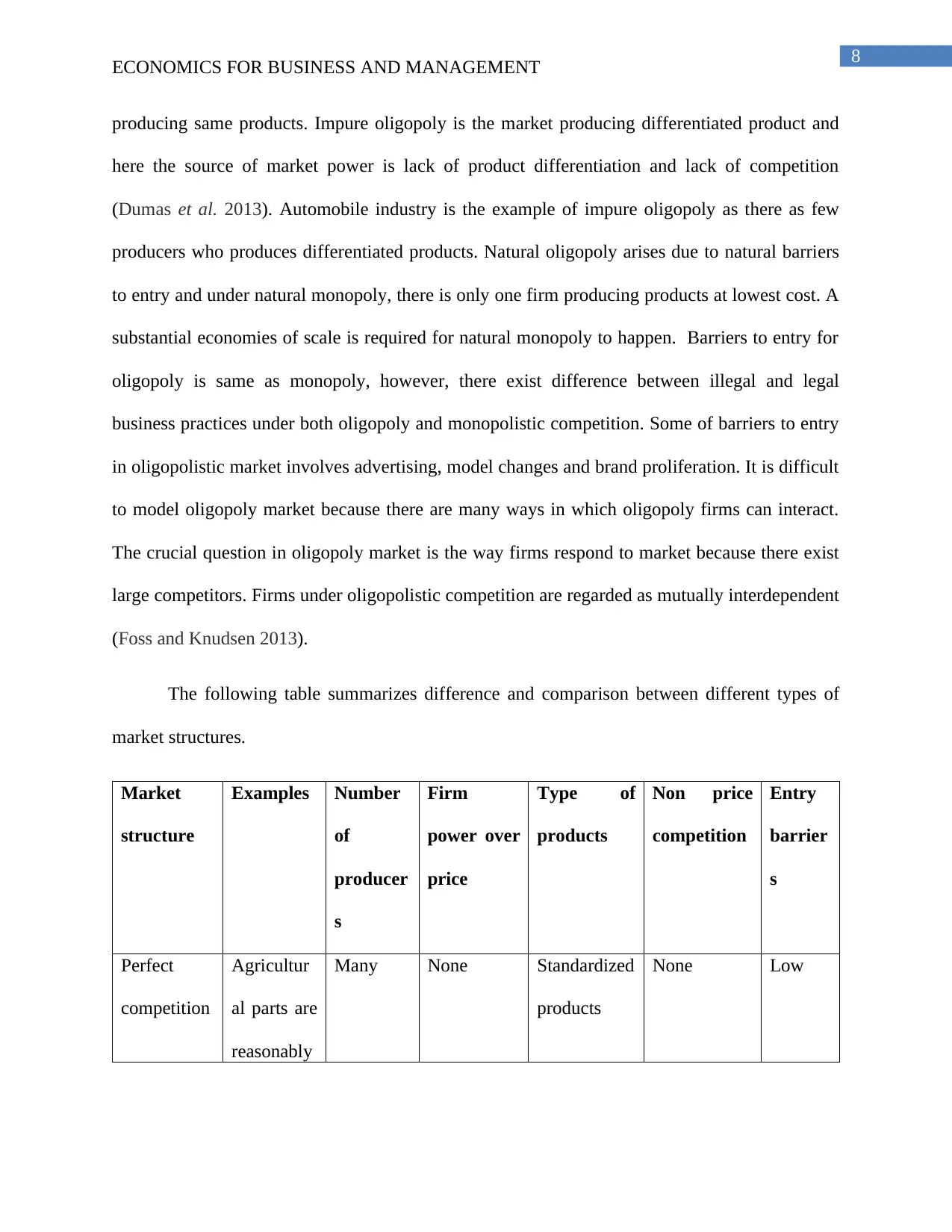
8
ECONOMICS FOR BUSINESS AND MANAGEMENT
producing same products. Impure oligopoly is the market producing differentiated product and
here the source of market power is lack of product differentiation and lack of competition
(Dumas et al. 2013). Automobile industry is the example of impure oligopoly as there as few
producers who produces differentiated products. Natural oligopoly arises due to natural barriers
to entry and under natural monopoly, there is only one firm producing products at lowest cost. A
substantial economies of scale is required for natural monopoly to happen. Barriers to entry for
oligopoly is same as monopoly, however, there exist difference between illegal and legal
business practices under both oligopoly and monopolistic competition. Some of barriers to entry
in oligopolistic market involves advertising, model changes and brand proliferation. It is difficult
to model oligopoly market because there are many ways in which oligopoly firms can interact.
The crucial question in oligopoly market is the way firms respond to market because there exist
large competitors. Firms under oligopolistic competition are regarded as mutually interdependent
(Foss and Knudsen 2013).
The following table summarizes difference and comparison between different types of
market structures.
Market
structure
Examples Number
of
producer
s
Firm
power over
price
Type of
products
Non price
competition
Entry
barrier
s
Perfect
competition
Agricultur
al parts are
reasonably
Many None Standardized
products
None Low
ECONOMICS FOR BUSINESS AND MANAGEMENT
producing same products. Impure oligopoly is the market producing differentiated product and
here the source of market power is lack of product differentiation and lack of competition
(Dumas et al. 2013). Automobile industry is the example of impure oligopoly as there as few
producers who produces differentiated products. Natural oligopoly arises due to natural barriers
to entry and under natural monopoly, there is only one firm producing products at lowest cost. A
substantial economies of scale is required for natural monopoly to happen. Barriers to entry for
oligopoly is same as monopoly, however, there exist difference between illegal and legal
business practices under both oligopoly and monopolistic competition. Some of barriers to entry
in oligopolistic market involves advertising, model changes and brand proliferation. It is difficult
to model oligopoly market because there are many ways in which oligopoly firms can interact.
The crucial question in oligopoly market is the way firms respond to market because there exist
large competitors. Firms under oligopolistic competition are regarded as mutually interdependent
(Foss and Knudsen 2013).
The following table summarizes difference and comparison between different types of
market structures.
Market
structure
Examples Number
of
producer
s
Firm
power over
price
Type of
products
Non price
competition
Entry
barrier
s
Perfect
competition
Agricultur
al parts are
reasonably
Many None Standardized
products
None Low
⊘ This is a preview!⊘
Do you want full access?
Subscribe today to unlock all pages.

Trusted by 1+ million students worldwide
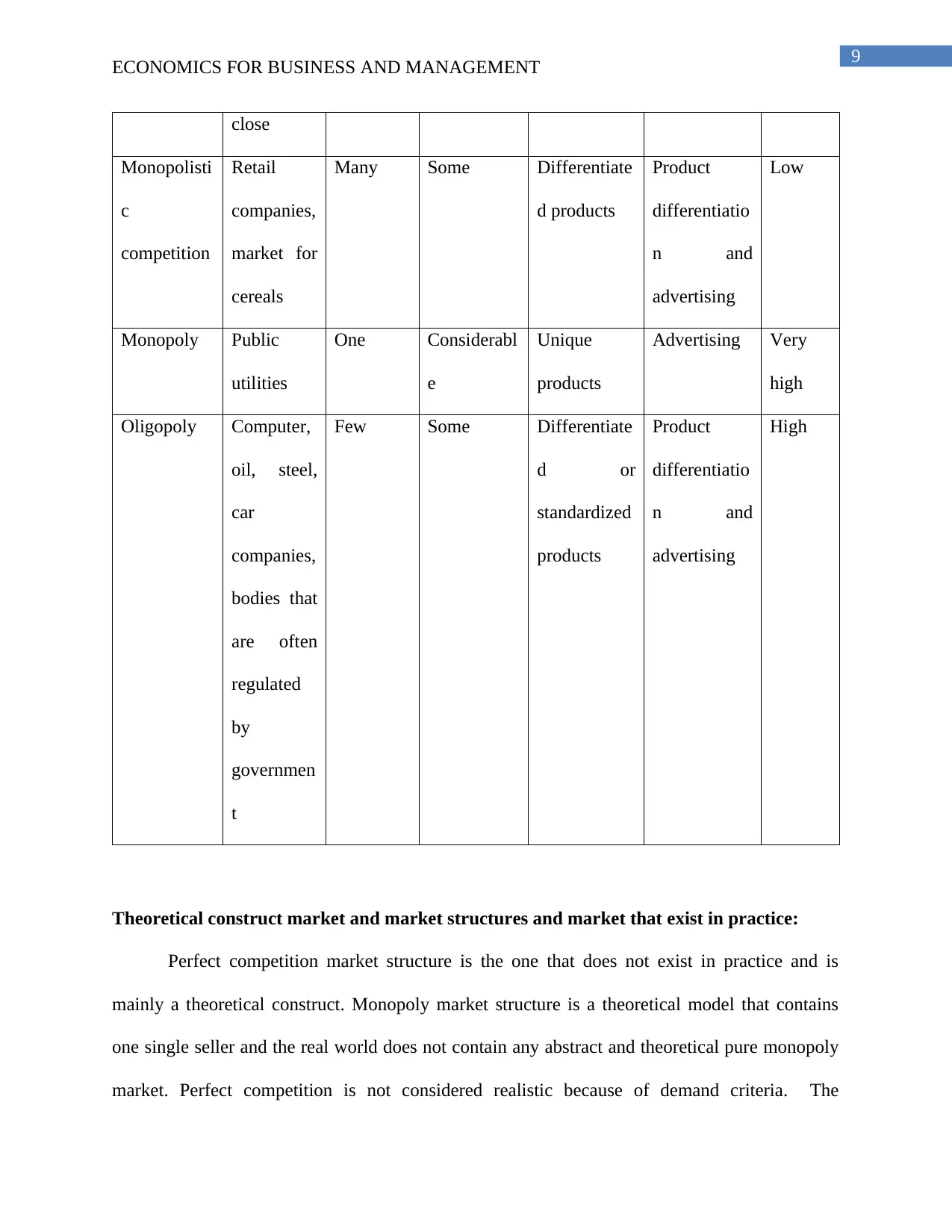
9
ECONOMICS FOR BUSINESS AND MANAGEMENT
close
Monopolisti
c
competition
Retail
companies,
market for
cereals
Many Some Differentiate
d products
Product
differentiatio
n and
advertising
Low
Monopoly Public
utilities
One Considerabl
e
Unique
products
Advertising Very
high
Oligopoly Computer,
oil, steel,
car
companies,
bodies that
are often
regulated
by
governmen
t
Few Some Differentiate
d or
standardized
products
Product
differentiatio
n and
advertising
High
Theoretical construct market and market structures and market that exist in practice:
Perfect competition market structure is the one that does not exist in practice and is
mainly a theoretical construct. Monopoly market structure is a theoretical model that contains
one single seller and the real world does not contain any abstract and theoretical pure monopoly
market. Perfect competition is not considered realistic because of demand criteria. The
ECONOMICS FOR BUSINESS AND MANAGEMENT
close
Monopolisti
c
competition
Retail
companies,
market for
cereals
Many Some Differentiate
d products
Product
differentiatio
n and
advertising
Low
Monopoly Public
utilities
One Considerabl
e
Unique
products
Advertising Very
high
Oligopoly Computer,
oil, steel,
car
companies,
bodies that
are often
regulated
by
governmen
t
Few Some Differentiate
d or
standardized
products
Product
differentiatio
n and
advertising
High
Theoretical construct market and market structures and market that exist in practice:
Perfect competition market structure is the one that does not exist in practice and is
mainly a theoretical construct. Monopoly market structure is a theoretical model that contains
one single seller and the real world does not contain any abstract and theoretical pure monopoly
market. Perfect competition is not considered realistic because of demand criteria. The
Paraphrase This Document
Need a fresh take? Get an instant paraphrase of this document with our AI Paraphraser
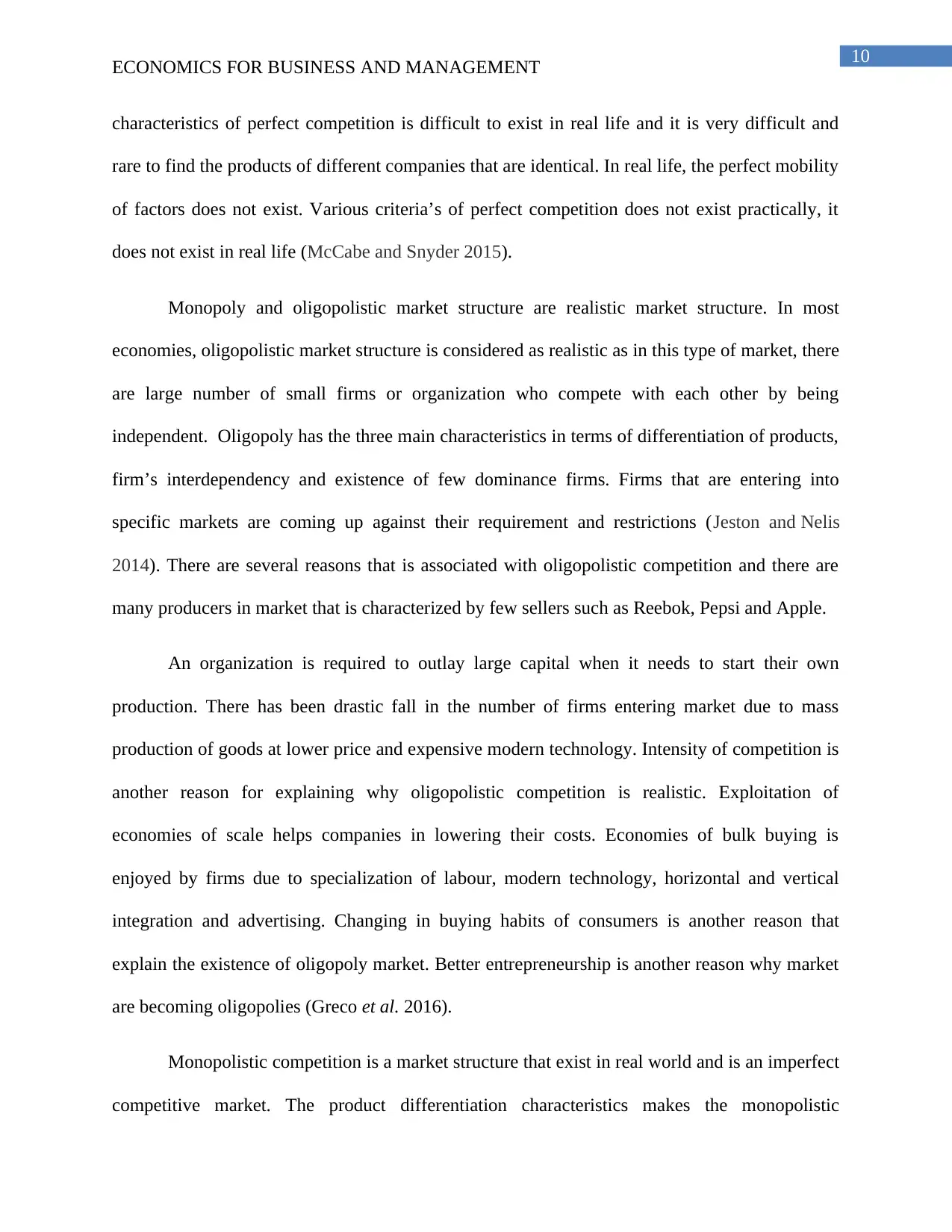
10
ECONOMICS FOR BUSINESS AND MANAGEMENT
characteristics of perfect competition is difficult to exist in real life and it is very difficult and
rare to find the products of different companies that are identical. In real life, the perfect mobility
of factors does not exist. Various criteria’s of perfect competition does not exist practically, it
does not exist in real life (McCabe and Snyder 2015).
Monopoly and oligopolistic market structure are realistic market structure. In most
economies, oligopolistic market structure is considered as realistic as in this type of market, there
are large number of small firms or organization who compete with each other by being
independent. Oligopoly has the three main characteristics in terms of differentiation of products,
firm’s interdependency and existence of few dominance firms. Firms that are entering into
specific markets are coming up against their requirement and restrictions (Jeston and Nelis
2014). There are several reasons that is associated with oligopolistic competition and there are
many producers in market that is characterized by few sellers such as Reebok, Pepsi and Apple.
An organization is required to outlay large capital when it needs to start their own
production. There has been drastic fall in the number of firms entering market due to mass
production of goods at lower price and expensive modern technology. Intensity of competition is
another reason for explaining why oligopolistic competition is realistic. Exploitation of
economies of scale helps companies in lowering their costs. Economies of bulk buying is
enjoyed by firms due to specialization of labour, modern technology, horizontal and vertical
integration and advertising. Changing in buying habits of consumers is another reason that
explain the existence of oligopoly market. Better entrepreneurship is another reason why market
are becoming oligopolies (Greco et al. 2016).
Monopolistic competition is a market structure that exist in real world and is an imperfect
competitive market. The product differentiation characteristics makes the monopolistic
ECONOMICS FOR BUSINESS AND MANAGEMENT
characteristics of perfect competition is difficult to exist in real life and it is very difficult and
rare to find the products of different companies that are identical. In real life, the perfect mobility
of factors does not exist. Various criteria’s of perfect competition does not exist practically, it
does not exist in real life (McCabe and Snyder 2015).
Monopoly and oligopolistic market structure are realistic market structure. In most
economies, oligopolistic market structure is considered as realistic as in this type of market, there
are large number of small firms or organization who compete with each other by being
independent. Oligopoly has the three main characteristics in terms of differentiation of products,
firm’s interdependency and existence of few dominance firms. Firms that are entering into
specific markets are coming up against their requirement and restrictions (Jeston and Nelis
2014). There are several reasons that is associated with oligopolistic competition and there are
many producers in market that is characterized by few sellers such as Reebok, Pepsi and Apple.
An organization is required to outlay large capital when it needs to start their own
production. There has been drastic fall in the number of firms entering market due to mass
production of goods at lower price and expensive modern technology. Intensity of competition is
another reason for explaining why oligopolistic competition is realistic. Exploitation of
economies of scale helps companies in lowering their costs. Economies of bulk buying is
enjoyed by firms due to specialization of labour, modern technology, horizontal and vertical
integration and advertising. Changing in buying habits of consumers is another reason that
explain the existence of oligopoly market. Better entrepreneurship is another reason why market
are becoming oligopolies (Greco et al. 2016).
Monopolistic competition is a market structure that exist in real world and is an imperfect
competitive market. The product differentiation characteristics makes the monopolistic
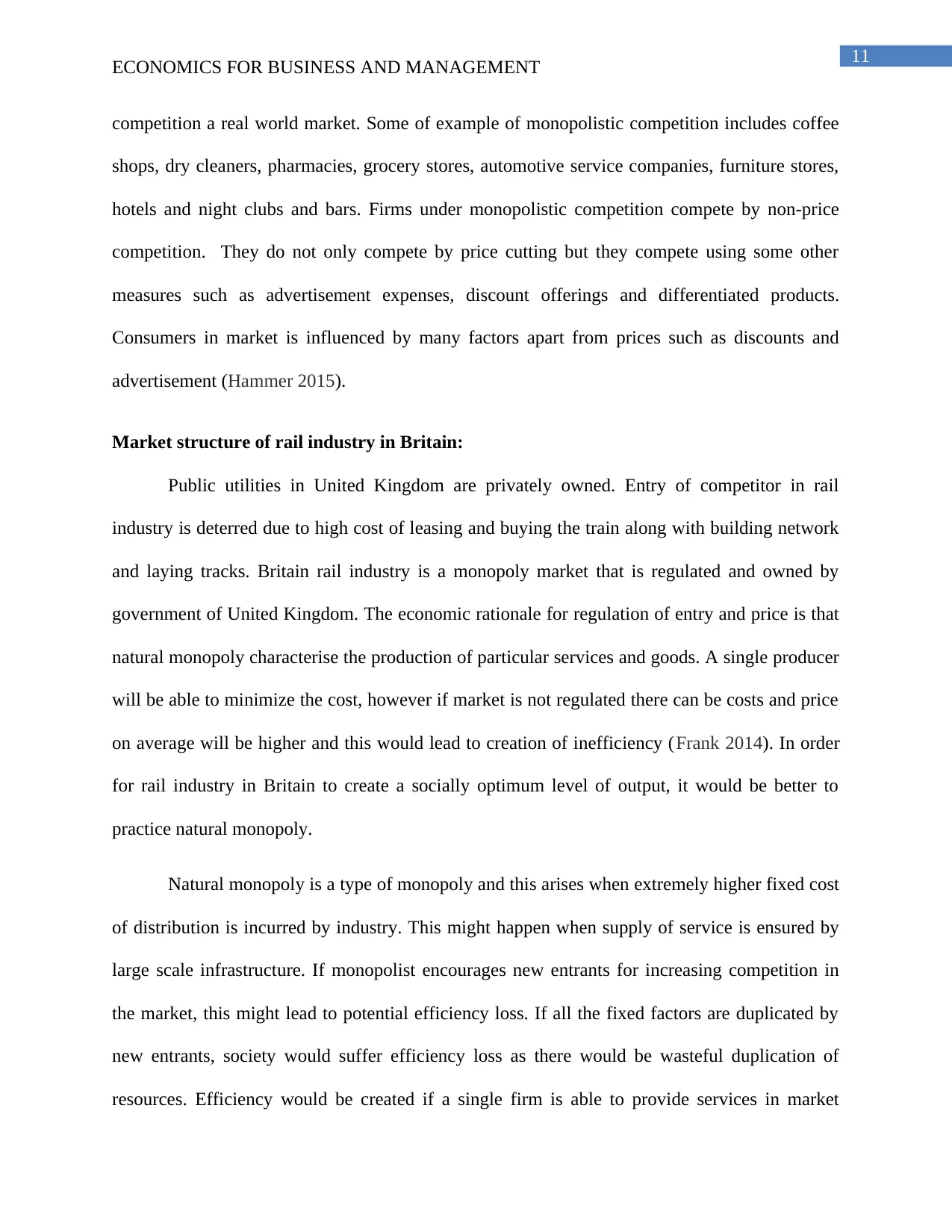
11
ECONOMICS FOR BUSINESS AND MANAGEMENT
competition a real world market. Some of example of monopolistic competition includes coffee
shops, dry cleaners, pharmacies, grocery stores, automotive service companies, furniture stores,
hotels and night clubs and bars. Firms under monopolistic competition compete by non-price
competition. They do not only compete by price cutting but they compete using some other
measures such as advertisement expenses, discount offerings and differentiated products.
Consumers in market is influenced by many factors apart from prices such as discounts and
advertisement (Hammer 2015).
Market structure of rail industry in Britain:
Public utilities in United Kingdom are privately owned. Entry of competitor in rail
industry is deterred due to high cost of leasing and buying the train along with building network
and laying tracks. Britain rail industry is a monopoly market that is regulated and owned by
government of United Kingdom. The economic rationale for regulation of entry and price is that
natural monopoly characterise the production of particular services and goods. A single producer
will be able to minimize the cost, however if market is not regulated there can be costs and price
on average will be higher and this would lead to creation of inefficiency (Frank 2014). In order
for rail industry in Britain to create a socially optimum level of output, it would be better to
practice natural monopoly.
Natural monopoly is a type of monopoly and this arises when extremely higher fixed cost
of distribution is incurred by industry. This might happen when supply of service is ensured by
large scale infrastructure. If monopolist encourages new entrants for increasing competition in
the market, this might lead to potential efficiency loss. If all the fixed factors are duplicated by
new entrants, society would suffer efficiency loss as there would be wasteful duplication of
resources. Efficiency would be created if a single firm is able to provide services in market
ECONOMICS FOR BUSINESS AND MANAGEMENT
competition a real world market. Some of example of monopolistic competition includes coffee
shops, dry cleaners, pharmacies, grocery stores, automotive service companies, furniture stores,
hotels and night clubs and bars. Firms under monopolistic competition compete by non-price
competition. They do not only compete by price cutting but they compete using some other
measures such as advertisement expenses, discount offerings and differentiated products.
Consumers in market is influenced by many factors apart from prices such as discounts and
advertisement (Hammer 2015).
Market structure of rail industry in Britain:
Public utilities in United Kingdom are privately owned. Entry of competitor in rail
industry is deterred due to high cost of leasing and buying the train along with building network
and laying tracks. Britain rail industry is a monopoly market that is regulated and owned by
government of United Kingdom. The economic rationale for regulation of entry and price is that
natural monopoly characterise the production of particular services and goods. A single producer
will be able to minimize the cost, however if market is not regulated there can be costs and price
on average will be higher and this would lead to creation of inefficiency (Frank 2014). In order
for rail industry in Britain to create a socially optimum level of output, it would be better to
practice natural monopoly.
Natural monopoly is a type of monopoly and this arises when extremely higher fixed cost
of distribution is incurred by industry. This might happen when supply of service is ensured by
large scale infrastructure. If monopolist encourages new entrants for increasing competition in
the market, this might lead to potential efficiency loss. If all the fixed factors are duplicated by
new entrants, society would suffer efficiency loss as there would be wasteful duplication of
resources. Efficiency would be created if a single firm is able to provide services in market
⊘ This is a preview!⊘
Do you want full access?
Subscribe today to unlock all pages.

Trusted by 1+ million students worldwide
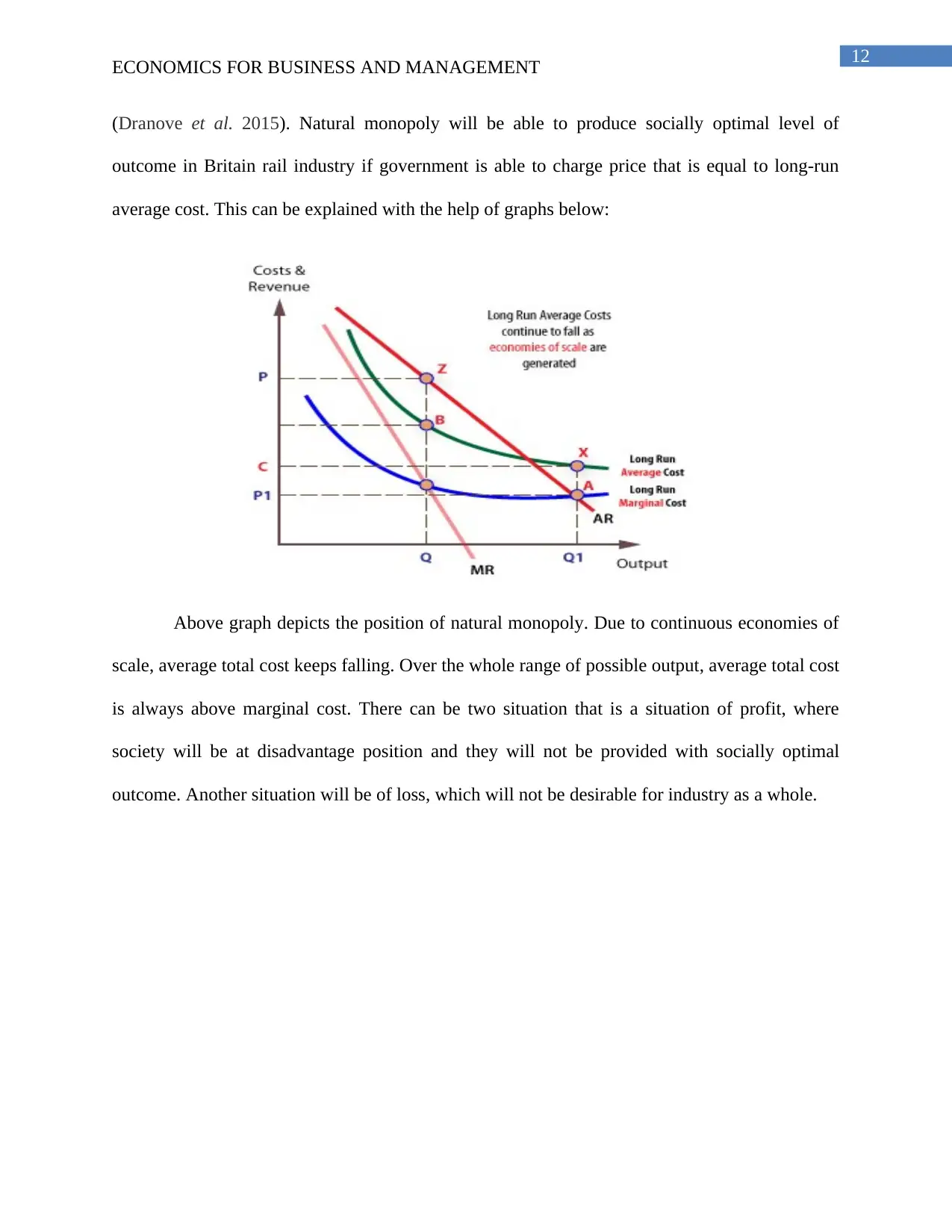
12
ECONOMICS FOR BUSINESS AND MANAGEMENT
(Dranove et al. 2015). Natural monopoly will be able to produce socially optimal level of
outcome in Britain rail industry if government is able to charge price that is equal to long-run
average cost. This can be explained with the help of graphs below:
Above graph depicts the position of natural monopoly. Due to continuous economies of
scale, average total cost keeps falling. Over the whole range of possible output, average total cost
is always above marginal cost. There can be two situation that is a situation of profit, where
society will be at disadvantage position and they will not be provided with socially optimal
outcome. Another situation will be of loss, which will not be desirable for industry as a whole.
ECONOMICS FOR BUSINESS AND MANAGEMENT
(Dranove et al. 2015). Natural monopoly will be able to produce socially optimal level of
outcome in Britain rail industry if government is able to charge price that is equal to long-run
average cost. This can be explained with the help of graphs below:
Above graph depicts the position of natural monopoly. Due to continuous economies of
scale, average total cost keeps falling. Over the whole range of possible output, average total cost
is always above marginal cost. There can be two situation that is a situation of profit, where
society will be at disadvantage position and they will not be provided with socially optimal
outcome. Another situation will be of loss, which will not be desirable for industry as a whole.
Paraphrase This Document
Need a fresh take? Get an instant paraphrase of this document with our AI Paraphraser
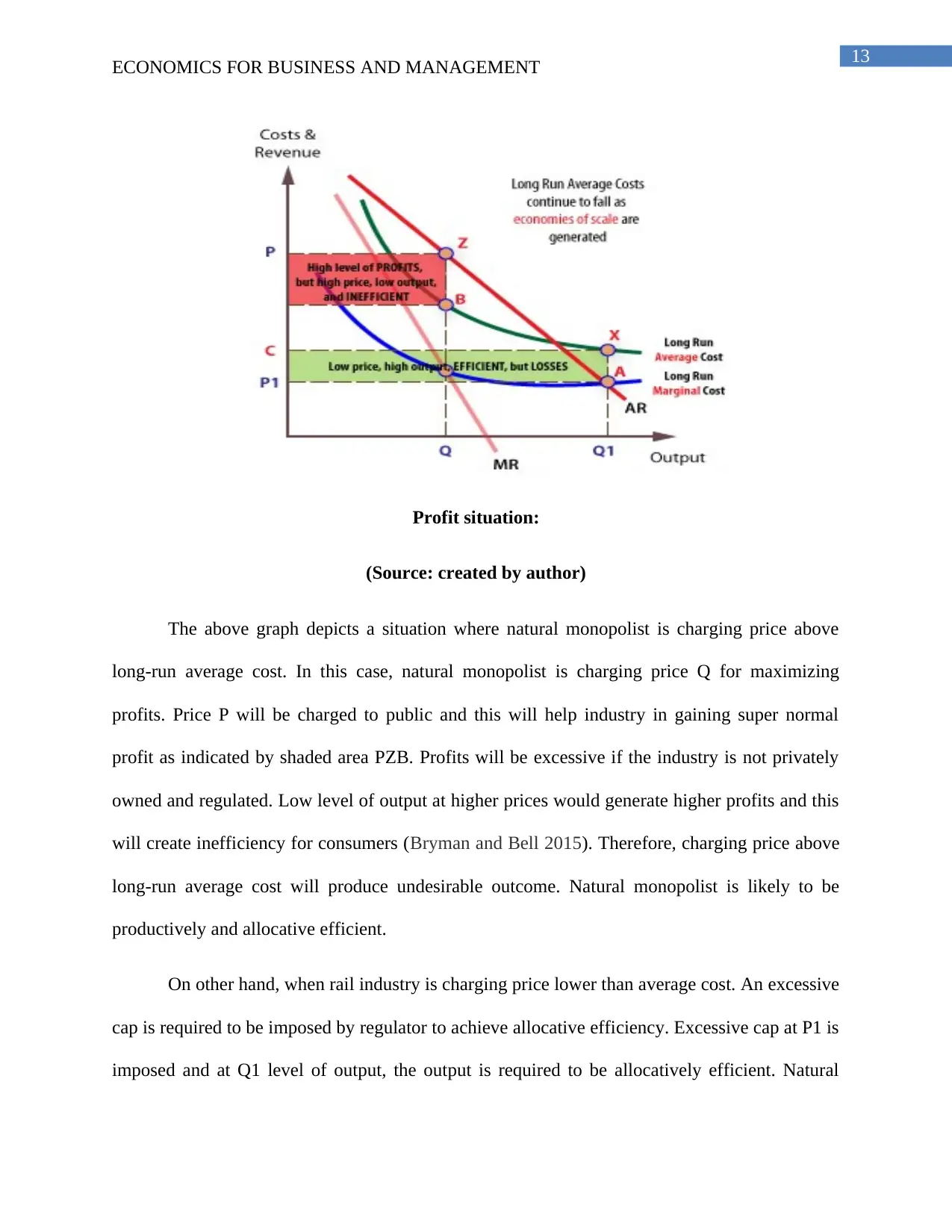
13
ECONOMICS FOR BUSINESS AND MANAGEMENT
Profit situation:
(Source: created by author)
The above graph depicts a situation where natural monopolist is charging price above
long-run average cost. In this case, natural monopolist is charging price Q for maximizing
profits. Price P will be charged to public and this will help industry in gaining super normal
profit as indicated by shaded area PZB. Profits will be excessive if the industry is not privately
owned and regulated. Low level of output at higher prices would generate higher profits and this
will create inefficiency for consumers (Bryman and Bell 2015). Therefore, charging price above
long-run average cost will produce undesirable outcome. Natural monopolist is likely to be
productively and allocative efficient.
On other hand, when rail industry is charging price lower than average cost. An excessive
cap is required to be imposed by regulator to achieve allocative efficiency. Excessive cap at P1 is
imposed and at Q1 level of output, the output is required to be allocatively efficient. Natural
ECONOMICS FOR BUSINESS AND MANAGEMENT
Profit situation:
(Source: created by author)
The above graph depicts a situation where natural monopolist is charging price above
long-run average cost. In this case, natural monopolist is charging price Q for maximizing
profits. Price P will be charged to public and this will help industry in gaining super normal
profit as indicated by shaded area PZB. Profits will be excessive if the industry is not privately
owned and regulated. Low level of output at higher prices would generate higher profits and this
will create inefficiency for consumers (Bryman and Bell 2015). Therefore, charging price above
long-run average cost will produce undesirable outcome. Natural monopolist is likely to be
productively and allocative efficient.
On other hand, when rail industry is charging price lower than average cost. An excessive
cap is required to be imposed by regulator to achieve allocative efficiency. Excessive cap at P1 is
imposed and at Q1 level of output, the output is required to be allocatively efficient. Natural
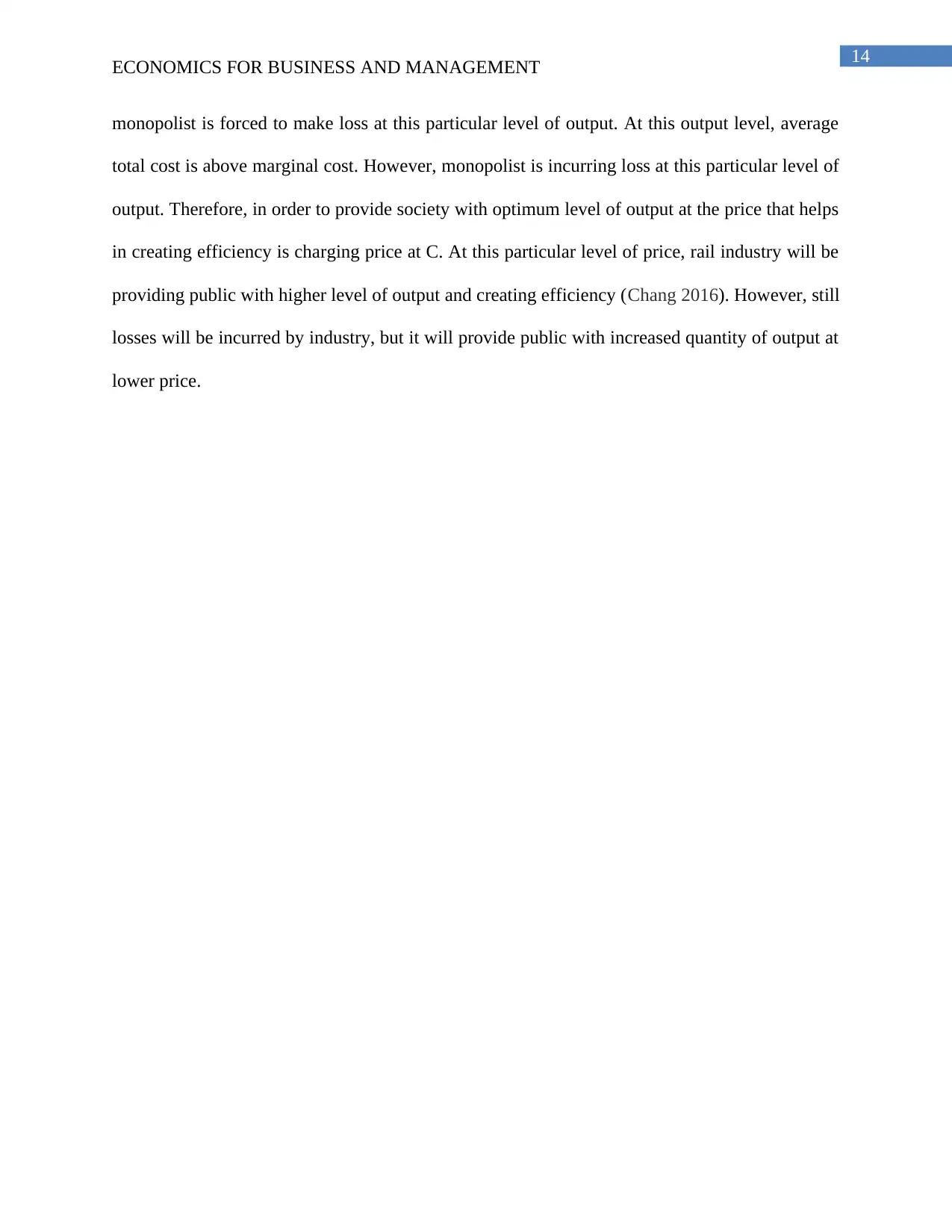
14
ECONOMICS FOR BUSINESS AND MANAGEMENT
monopolist is forced to make loss at this particular level of output. At this output level, average
total cost is above marginal cost. However, monopolist is incurring loss at this particular level of
output. Therefore, in order to provide society with optimum level of output at the price that helps
in creating efficiency is charging price at C. At this particular level of price, rail industry will be
providing public with higher level of output and creating efficiency (Chang 2016). However, still
losses will be incurred by industry, but it will provide public with increased quantity of output at
lower price.
ECONOMICS FOR BUSINESS AND MANAGEMENT
monopolist is forced to make loss at this particular level of output. At this output level, average
total cost is above marginal cost. However, monopolist is incurring loss at this particular level of
output. Therefore, in order to provide society with optimum level of output at the price that helps
in creating efficiency is charging price at C. At this particular level of price, rail industry will be
providing public with higher level of output and creating efficiency (Chang 2016). However, still
losses will be incurred by industry, but it will provide public with increased quantity of output at
lower price.
⊘ This is a preview!⊘
Do you want full access?
Subscribe today to unlock all pages.

Trusted by 1+ million students worldwide

15
ECONOMICS FOR BUSINESS AND MANAGEMENT
References list:
Anderson, D.R., Sweeney, D.J., Williams, T.A., Camm, J.D. and Cochran, J.J., 2014. Statistics
for business & economics, revised. Cengage Learning.
Bryman, A. and Bell, E., 2015. Business research methods. Oxford University Press, USA.
Carroll, A. and Buchholtz, A., 2014. Business and society: Ethics, sustainability, and stakeholder
management. Nelson Education.
Chang, J.F., 2016. Business process management systems: strategy and implementation. CRC
Press.
Dranove, D., Besanko, D., Shanley, M. and Schaefer, M., 2015. Economics of Strategy. Wiley
Global Education.
Dumas, M., La Rosa, M., Mendling, J. and Reijers, H.A., 2013. Fundamentals of business
process management (Vol. 1, p. 2). Heidelberg: Springer.
Foss, N.J. and Knudsen, C. eds., 2013. Towards a competence theory of the firm (Vol. 2).
Routledge.
Frank, R., 2014. Microeconomics and behavior. McGraw-Hill Higher Education.
Granger, C.W.J., 2014. Forecasting in business and economics. Academic Press.
Greco, S., Matarazzo, B. and Słowiński, R., 2016. Decision rule approach. In Multiple criteria
decision analysis (pp. 497-552). Springer New York.
Hammer, M., 2015. What is business process management?. In Handbook on Business Process
Management 1 (pp. 3-16). Springer, Berlin, Heidelberg.
Harmon, P., 2015. The scope and evolution of business process management. In Handbook on
business process management 1 (pp. 37-80). Springer, Berlin, Heidelberg.
Jeston, J. and Nelis, J., 2014. Business process management. Routledge.
ECONOMICS FOR BUSINESS AND MANAGEMENT
References list:
Anderson, D.R., Sweeney, D.J., Williams, T.A., Camm, J.D. and Cochran, J.J., 2014. Statistics
for business & economics, revised. Cengage Learning.
Bryman, A. and Bell, E., 2015. Business research methods. Oxford University Press, USA.
Carroll, A. and Buchholtz, A., 2014. Business and society: Ethics, sustainability, and stakeholder
management. Nelson Education.
Chang, J.F., 2016. Business process management systems: strategy and implementation. CRC
Press.
Dranove, D., Besanko, D., Shanley, M. and Schaefer, M., 2015. Economics of Strategy. Wiley
Global Education.
Dumas, M., La Rosa, M., Mendling, J. and Reijers, H.A., 2013. Fundamentals of business
process management (Vol. 1, p. 2). Heidelberg: Springer.
Foss, N.J. and Knudsen, C. eds., 2013. Towards a competence theory of the firm (Vol. 2).
Routledge.
Frank, R., 2014. Microeconomics and behavior. McGraw-Hill Higher Education.
Granger, C.W.J., 2014. Forecasting in business and economics. Academic Press.
Greco, S., Matarazzo, B. and Słowiński, R., 2016. Decision rule approach. In Multiple criteria
decision analysis (pp. 497-552). Springer New York.
Hammer, M., 2015. What is business process management?. In Handbook on Business Process
Management 1 (pp. 3-16). Springer, Berlin, Heidelberg.
Harmon, P., 2015. The scope and evolution of business process management. In Handbook on
business process management 1 (pp. 37-80). Springer, Berlin, Heidelberg.
Jeston, J. and Nelis, J., 2014. Business process management. Routledge.
Paraphrase This Document
Need a fresh take? Get an instant paraphrase of this document with our AI Paraphraser
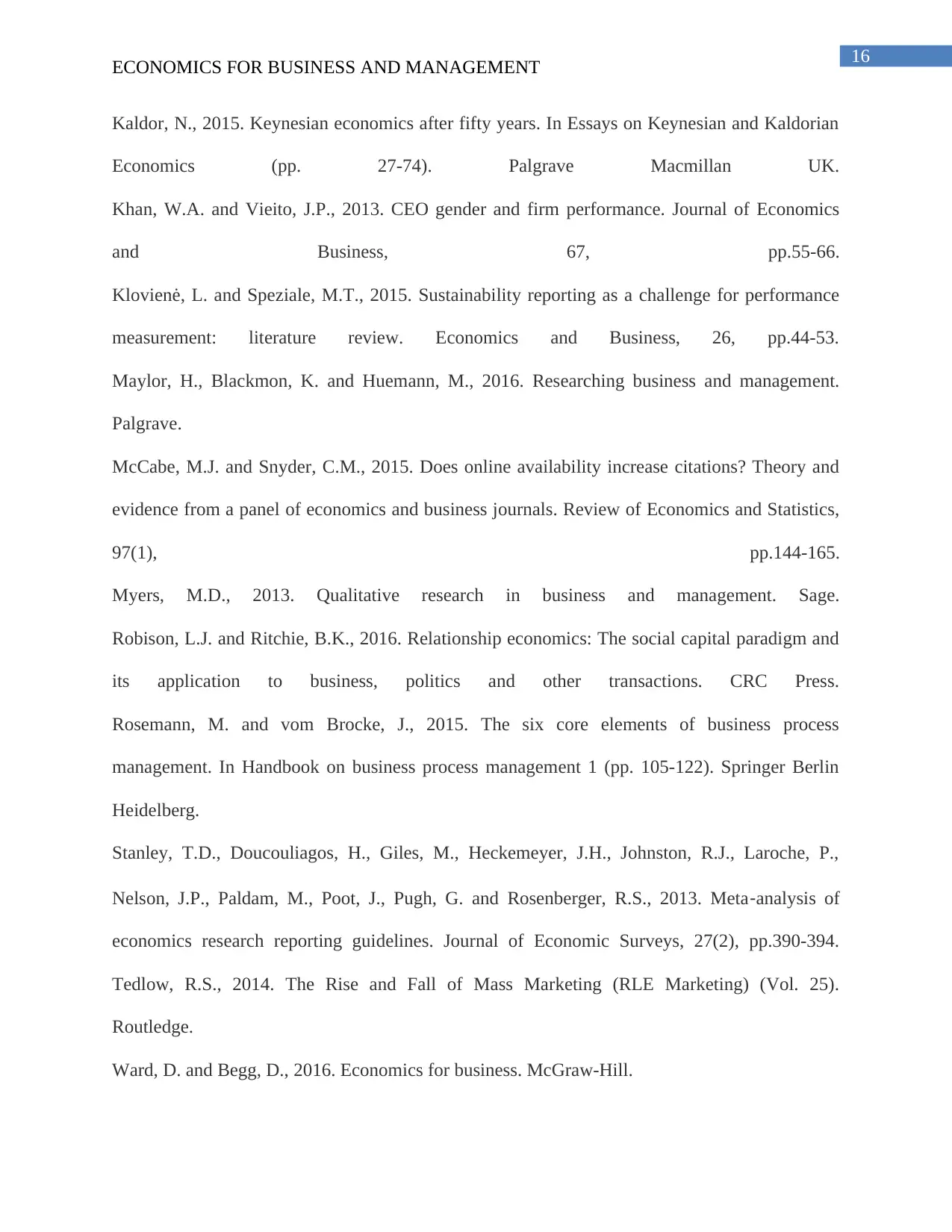
16
ECONOMICS FOR BUSINESS AND MANAGEMENT
Kaldor, N., 2015. Keynesian economics after fifty years. In Essays on Keynesian and Kaldorian
Economics (pp. 27-74). Palgrave Macmillan UK.
Khan, W.A. and Vieito, J.P., 2013. CEO gender and firm performance. Journal of Economics
and Business, 67, pp.55-66.
Klovienė, L. and Speziale, M.T., 2015. Sustainability reporting as a challenge for performance
measurement: literature review. Economics and Business, 26, pp.44-53.
Maylor, H., Blackmon, K. and Huemann, M., 2016. Researching business and management.
Palgrave.
McCabe, M.J. and Snyder, C.M., 2015. Does online availability increase citations? Theory and
evidence from a panel of economics and business journals. Review of Economics and Statistics,
97(1), pp.144-165.
Myers, M.D., 2013. Qualitative research in business and management. Sage.
Robison, L.J. and Ritchie, B.K., 2016. Relationship economics: The social capital paradigm and
its application to business, politics and other transactions. CRC Press.
Rosemann, M. and vom Brocke, J., 2015. The six core elements of business process
management. In Handbook on business process management 1 (pp. 105-122). Springer Berlin
Heidelberg.
Stanley, T.D., Doucouliagos, H., Giles, M., Heckemeyer, J.H., Johnston, R.J., Laroche, P.,
Nelson, J.P., Paldam, M., Poot, J., Pugh, G. and Rosenberger, R.S., 2013. Meta‐analysis of
economics research reporting guidelines. Journal of Economic Surveys, 27(2), pp.390-394.
Tedlow, R.S., 2014. The Rise and Fall of Mass Marketing (RLE Marketing) (Vol. 25).
Routledge.
Ward, D. and Begg, D., 2016. Economics for business. McGraw-Hill.
ECONOMICS FOR BUSINESS AND MANAGEMENT
Kaldor, N., 2015. Keynesian economics after fifty years. In Essays on Keynesian and Kaldorian
Economics (pp. 27-74). Palgrave Macmillan UK.
Khan, W.A. and Vieito, J.P., 2013. CEO gender and firm performance. Journal of Economics
and Business, 67, pp.55-66.
Klovienė, L. and Speziale, M.T., 2015. Sustainability reporting as a challenge for performance
measurement: literature review. Economics and Business, 26, pp.44-53.
Maylor, H., Blackmon, K. and Huemann, M., 2016. Researching business and management.
Palgrave.
McCabe, M.J. and Snyder, C.M., 2015. Does online availability increase citations? Theory and
evidence from a panel of economics and business journals. Review of Economics and Statistics,
97(1), pp.144-165.
Myers, M.D., 2013. Qualitative research in business and management. Sage.
Robison, L.J. and Ritchie, B.K., 2016. Relationship economics: The social capital paradigm and
its application to business, politics and other transactions. CRC Press.
Rosemann, M. and vom Brocke, J., 2015. The six core elements of business process
management. In Handbook on business process management 1 (pp. 105-122). Springer Berlin
Heidelberg.
Stanley, T.D., Doucouliagos, H., Giles, M., Heckemeyer, J.H., Johnston, R.J., Laroche, P.,
Nelson, J.P., Paldam, M., Poot, J., Pugh, G. and Rosenberger, R.S., 2013. Meta‐analysis of
economics research reporting guidelines. Journal of Economic Surveys, 27(2), pp.390-394.
Tedlow, R.S., 2014. The Rise and Fall of Mass Marketing (RLE Marketing) (Vol. 25).
Routledge.
Ward, D. and Begg, D., 2016. Economics for business. McGraw-Hill.
1 out of 17
Related Documents
Your All-in-One AI-Powered Toolkit for Academic Success.
+13062052269
info@desklib.com
Available 24*7 on WhatsApp / Email
![[object Object]](/_next/static/media/star-bottom.7253800d.svg)
Unlock your academic potential
© 2024 | Zucol Services PVT LTD | All rights reserved.





